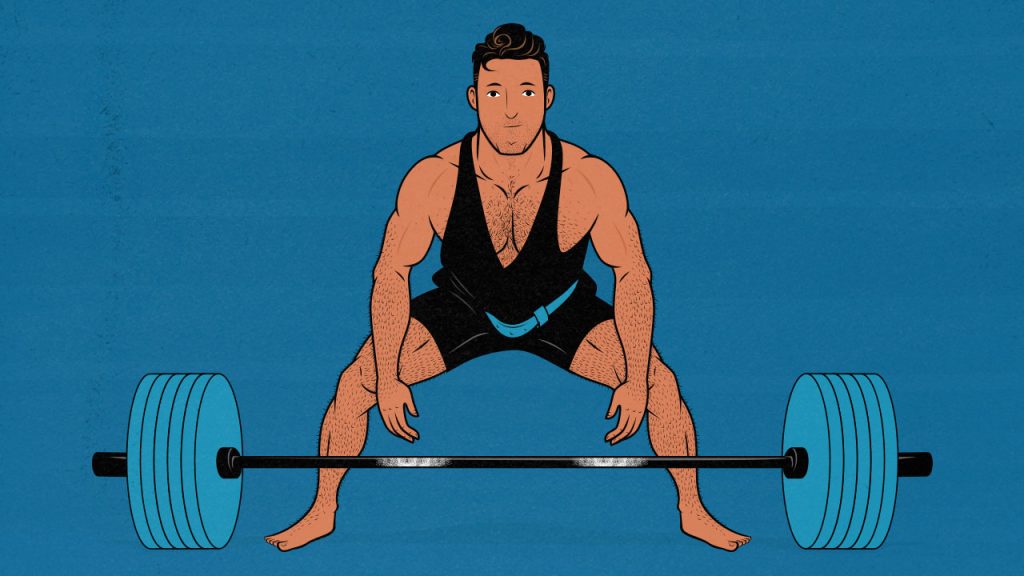
How Long Should You Rest Between Sets to Build Muscle?
Rest times are often brushed aside. You’ll hear that they matter, sure, but that they aren’t one of the more important factors—that they’ll only have a negligible impact on your muscle growth. That’s not necessarily true.
If we look at the research, using proper rest times can double your muscle growth or, if you do it the wrong way around, cut your muscle growth in half.
But it’s not quite as simple as long or short rest times being better for building muscle. Thankfully, there’s more than one way to unskinny a cat.
Let’s dive into it.
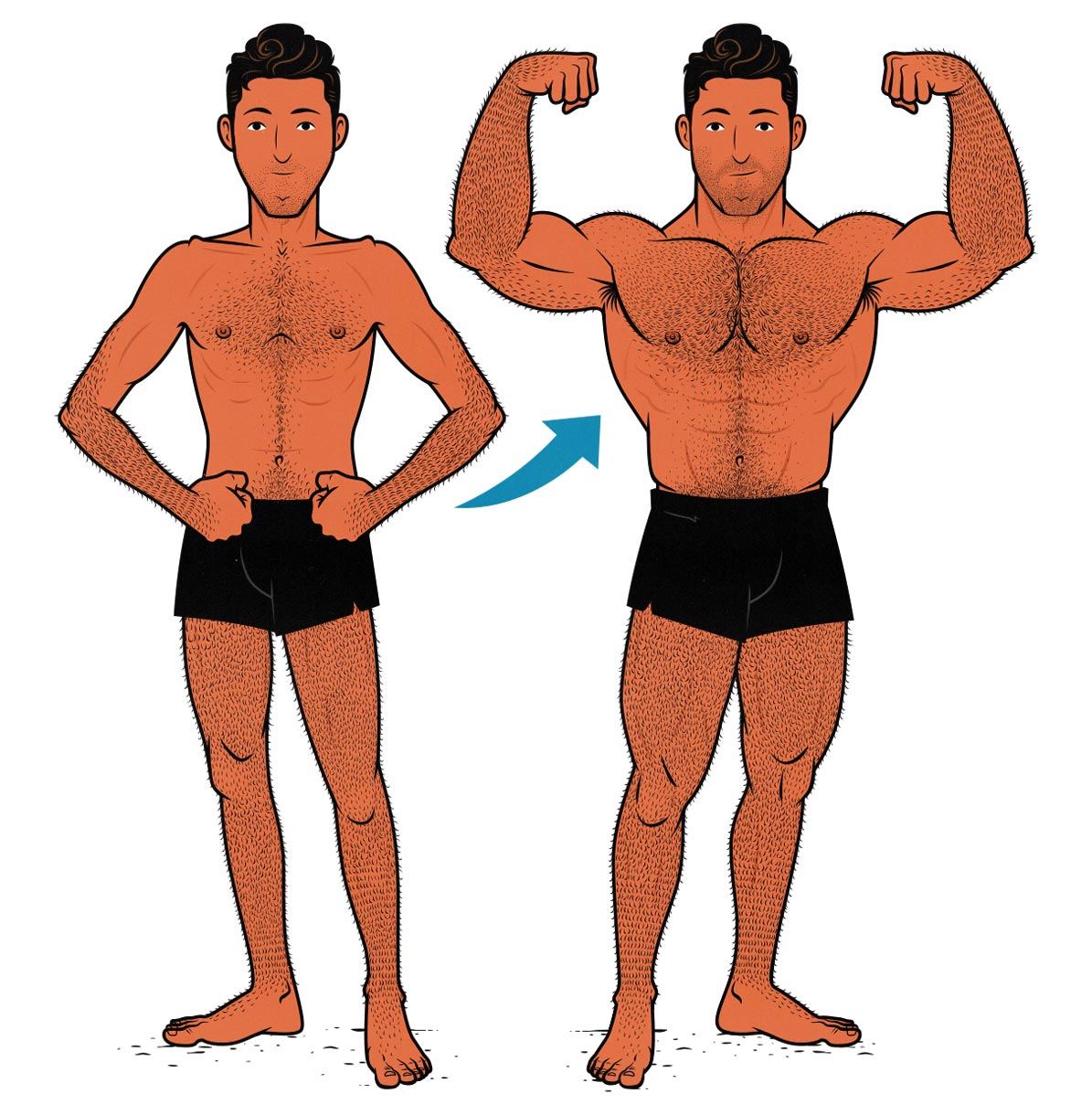
The Golden Age of Rest Times
Back in the golden age of bodybuilding, everyone was all about short rest times. They’d lift hard, rest quickly, and then leap back into the next set. Their heart rates would stay elevated all through their workouts, they’d get great muscle pumps, and they’d pack in a ton of sets and exercises.
If you take 5 minutes between each set, your heart rate slows down, you lose your pump, the muscles get cold, and your level of intensity drops down to nothing. Try to keep your rest periods between sets down to a minute or less.
Arnold Schwarzenegger, The Encyclopedia of Modern Bodybuilding
For an example of how that looks, here’s the first workout in Schwarzenegger’s beginner bodybuilding routine:
- Bench Press: 4 sets of 8 repetitions (4×8)
- Incline Press: 4×8
- Pullovers: 4×8
- Chin-Ups: 4×8
- Bent-Over Rows: 4×8
- Deadlifts: 4×8
- Crunches: 4×8
Rest: 1 minute of rest between sets.
Volume: 28 sets per workout.
Powerlifters would train more sparsely. They would take longer rest periods and do fewer exercises, even when they were trying to bulk up. They would often spend about the same amount of time in the gym as the bodybuilders, but much more of that time would be spent resting. The idea was to recover their strength before demolishing the next set, especially on their compound lifts.
For an example of that, here’s the first workout from Starting Strength, a beginner strength training routine made by the former powerlifter Mark Rippetoe:
- Squat: 3×5
- Bench Press: 3×5
- Deadlift: 1×5
Rest: 7–10 minutes of rest between sets.
Volume: 7 sets per workout.
Bodybuilders and powerlifters were using completely different styles of training. Bodybuilders were all about training density, blasting through set after set, even if that meant huge drops in performance as they progressed through their workouts. Powerlifters were all about maintaining high performance from set to set, even if that meant spending most of their workouts resting.
Then, in 2016, Dr. Brad Schoenfeld published a study that ravaged the landscape (study).
The Schoenfeld Study
Dr. Schoenfeld had the first group rest for one minute between sets, which was fairly typical for bodybuilders back then. He had the second group rest for three minutes between sets, more similar to how a powerlifter might rest after going up a flight of stairs. Each group did three sets of each exercise.
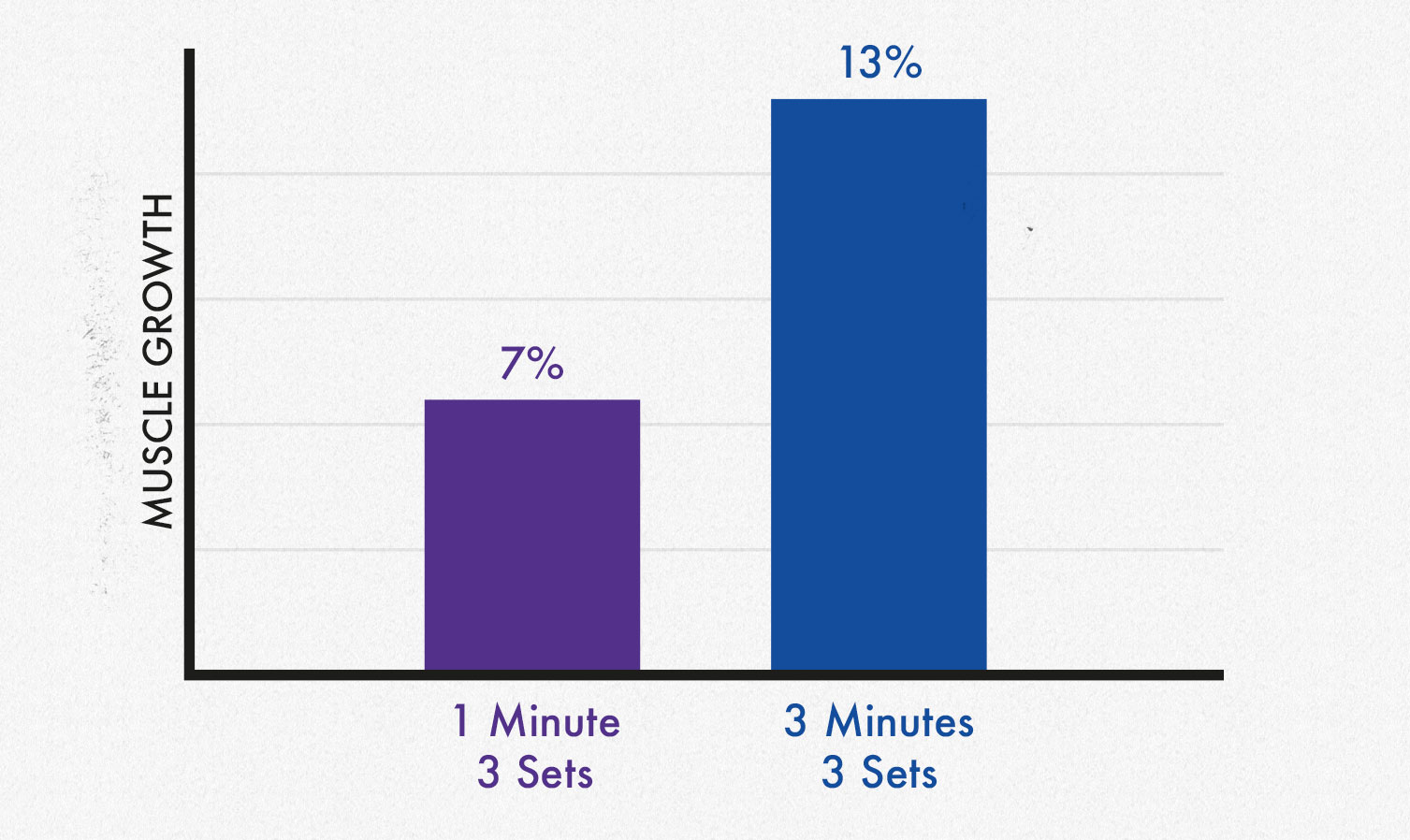
The group using short rest times built muscle just fine. But the group using longer rest times wound up gaining twice as much. A huge increase. So that means that longer rest times are better, right? Not quite, but a lot of people came away with that conclusion, and it’s easy to see why.
The study struck the lifting community like a war hammer. It didn’t kill the dogma outright—bodybuilders aren’t so easily dissuaded. But it was a debilitating blow, and short rest times have never made a full recovery.
Nowadays, the standard bulking advice is to rest like a powerlifter. You take the time you need to feel fully recovered, or at least mostly recovered. Depending on how much weight you’re moving and how fit you are, maybe that means resting for 2 minutes. Maybe 3. Maybe 5.
And that’s too bad. The classic bodybuilders were onto something.
The Longo Study
A few years later, Longo and colleagues published a follow-up study (study). Schoenfeld was an author of this study, too, actually. Anyway, just like in the first study, the participants did three sets with one minute of rest, and they compared that to three sets with three minutes of rest. And just like in that first study, the participants who used longer rest times gained twice as much muscle. Case closed, right?
But bodybuilders don’t train like that. They aren’t doing quick little workouts and calling it a day. They’re in the gym just as long as the powerlifters, doing more exercises, training obscure body parts, and blasting away at drop sets.
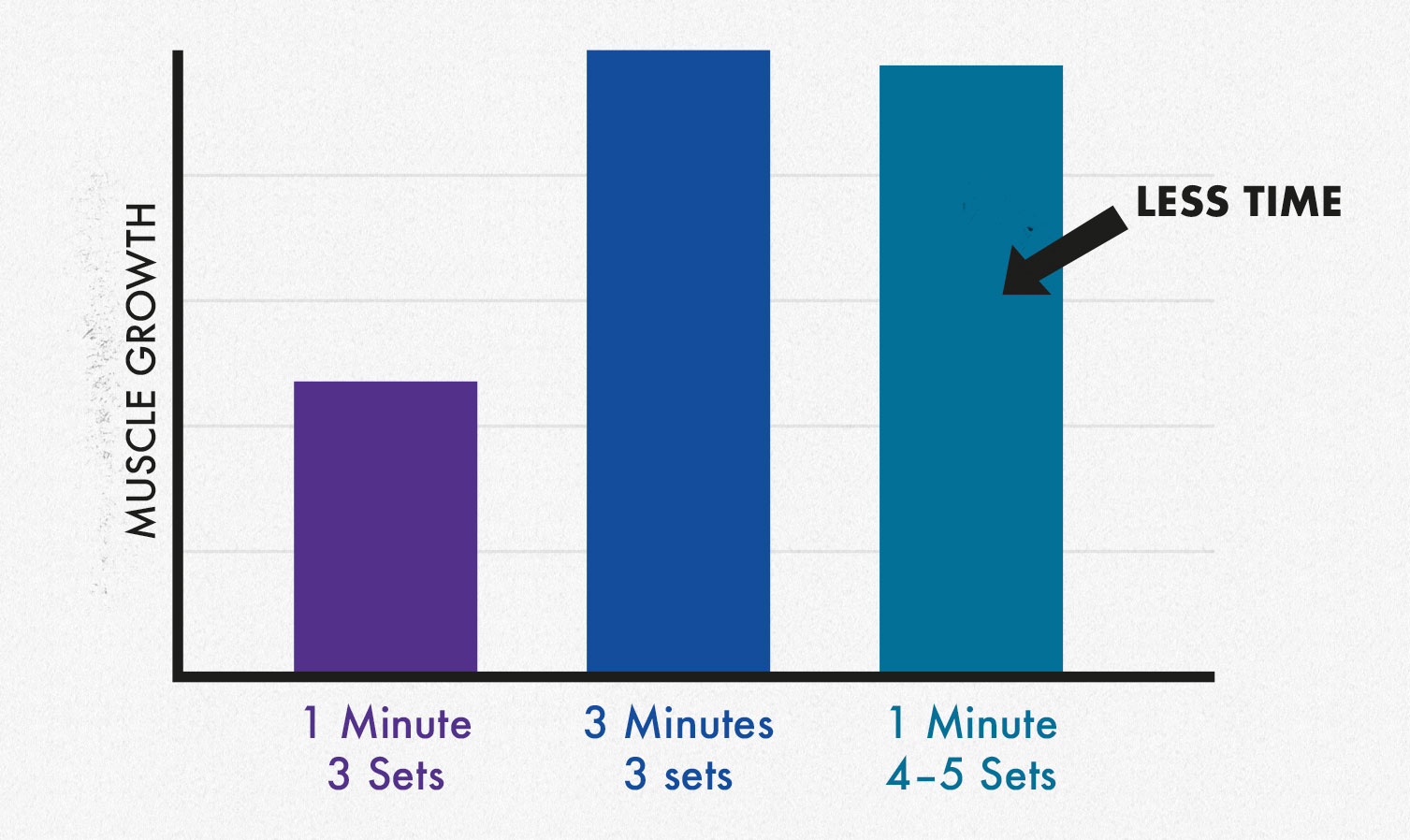
So Longo tested what would happen if the group using shorter rest times used some of their extra time to add in an extra set or two. In that case, they got the same amount of muscle growth as the group using longer rest periods, and they were still able to finish their workouts in less time.
The point is: short rest times will get you out of the gym slightly faster, but if you aren’t in a rush, it doesn’t really matter. The real trick is to line up your rest times with your style of training. You can’t rush through a powerlifting workout because you won’t be able to get enough heavy reps in. And you can’t sleep through a bodybuilding workout because you’ll be in the gym for 4 hours, and you’ll fall behind on your calories.
So pick your goal, and then choose the right rest times:
- Short rest periods: people usually use shorter rest times to work on their conditioning. The idea is to get better at recovering between sets. The trick is to add about 50% more total sets. Maybe that means doing more sets per exercise, or maybe that means adding in a couple of extra exercises.
- Long rest periods: using longer rest times tends to be better for gaining maximal strength, especially if you’re trying to apply that strength to sports like powerlifting. That way, you can give each set your best effort, really focusing on recruiting all of your motor units and exploding the weight up.
Or, if you want the best of both worlds, you can use a mix of both approaches. Maybe you train your big lifts with longer rest times (3–5 minutes) and then blast through your accessory lifts (30–60 seconds). You could even take it one step further, finishing up your workout with some drop sets, where you aren’t resting at all between sets.
Or you could spend a couple of months using shorter rest times, training more like a bodybuilder and working on your conditioning. And then spend a couple of months using longer rest times, training more like a powerlifter and working on your maximal strength.
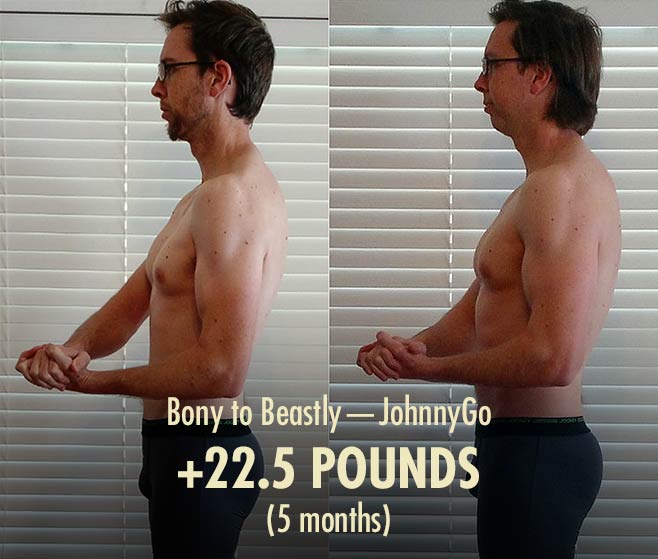
That’s what we try to do in our programs. We use a strategic mix of shorter and longer rest periods, sometimes within the same workout, sometimes between different phases.
Different People, Different Rest Times
The other thing to keep in mind is that different people have different degrees of strength and fitness. The stronger you are, the more weight you’ll be lifting, the more muscle mass you’ll be working, and so the more rest you’ll need between sets. And the fitter you are, the better you’ll be at recovering between sets.
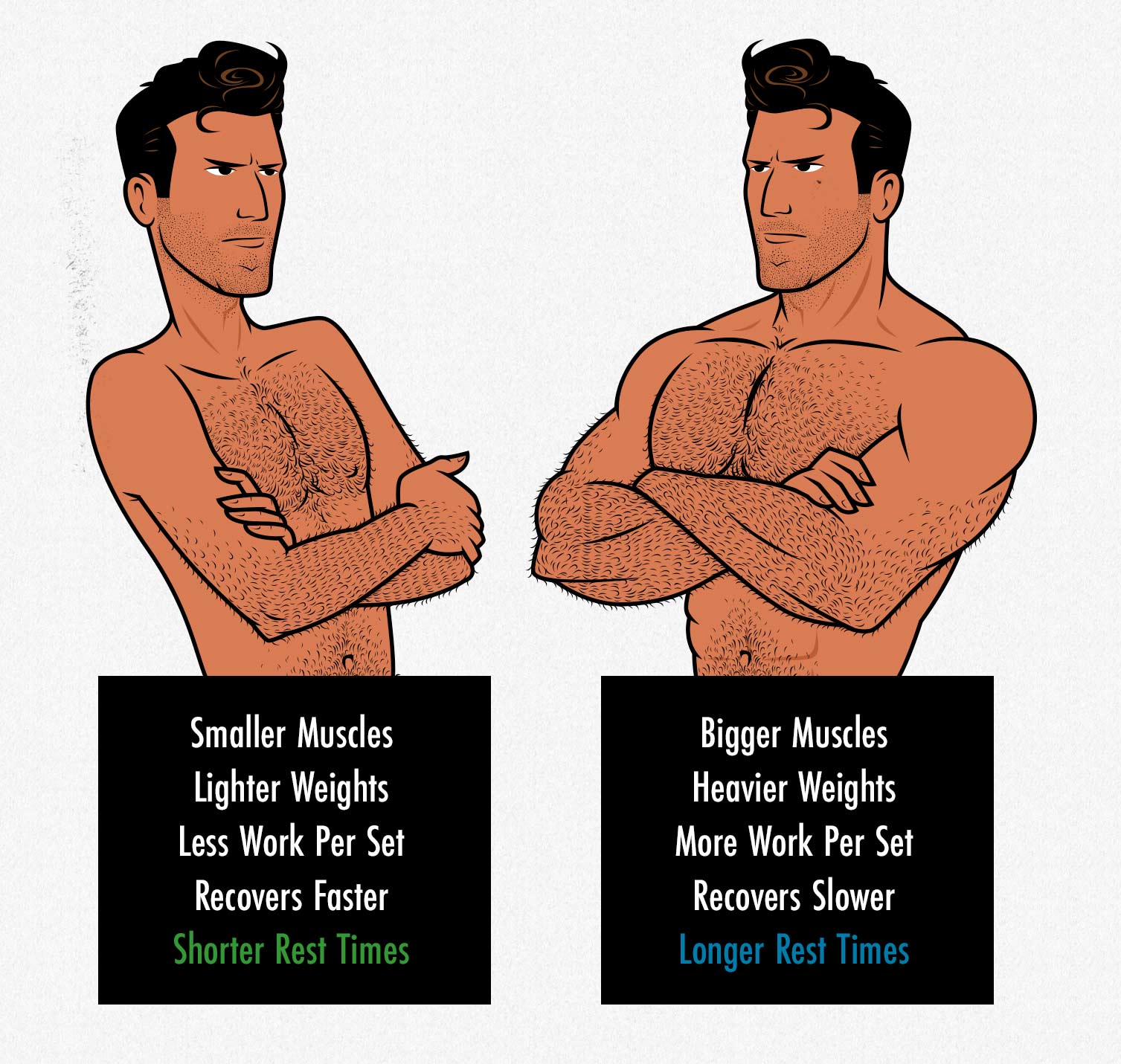
So, as you can imagine, skinny beginners after often able to get away with relatively short rest times. We aren’t lifting that much weight, and we aren’t working that much overall muscle mass, allowing us to recover more quickly between sets. You might only need two minutes of rest after a hard set of squats, not five, and certainly not ten. That’s even more true when doing smaller isolation lifts. We’re lifting even less weight and working even less muscle mass. You might only need a minute between your sets of biceps curls.
If you want to recover completely between sets, a good rule of thumb is to rest for 3–5 minutes after your biggest lifts, like squats and deadlifts. For your other lifts, you can rest for 1–3 minutes between sets. If you’re skinny, weak, or fit, you can err on the shorter side. If you’re bigger, stronger, or out of shape, you can err on the longer side. A good trick is to pay attention to your breathing. Don’t get distracted by your phone; just sit or pace, waiting. When your breathing has calmed back down, you’re probably ready for your next set.
Or you could use shorter rest times on purpose, beginning your next set before you’ve fully recovered. Just remember that when you’re using shorter rest times, you should also be doing around 50% more sets per workout, especially if you’re using intensity techniques like drop sets.
Summary
Longer rest times allow you to recover more of your strength between sets, allowing you to do more work and thus allowing you to stimulate more muscle growth per set. The downside is you’ll need to spend more time resting, reducing the amount of work you’re doing and thus reducing the amount of muscle growth you can stimulate in any given period of time. It’s a tradeoff.
So, if you use longer rest times, you won’t need to do as many sets. If you use shorter rest times, you’ll need to do around 50% more sets, but you can blast through them faster, allowing you to finish your workouts in slightly less time. Both approaches are equally good for building muscle. We recommend using a mix of both.
However long you rest, you still need to focus on progressive overload. Every workout, you should be fighting to add a bit of weight or eke out some extra reps. You won’t always see progress on every lift in every workout, but you do need to make sure you’re getting stronger from week to week, month to month, and year to year.

Alright, that’s it for now. If you want more muscle-building information, we have a free bulking newsletter for skinny guys. If you want a full foundational bulking program, including a 5-month full-body workout routine, a diet guide, online coaching, and a recipe book, check out our Bony to Beastly Bulking Program. Or, if you want a customizable intermediate bulking program, check out our Outlift Program.

